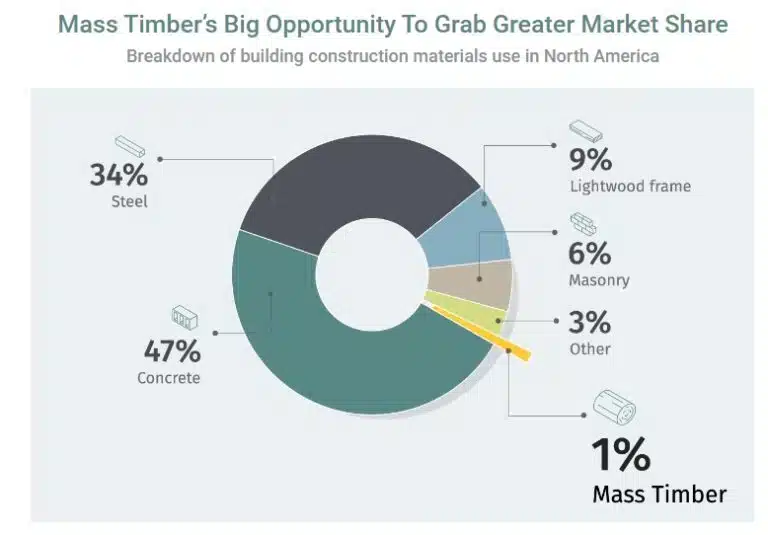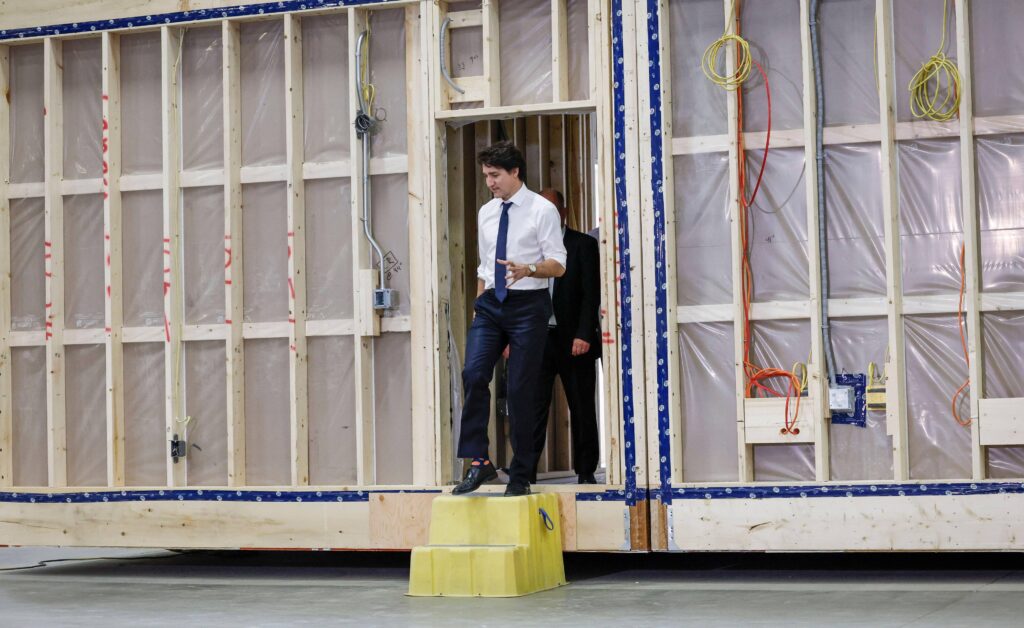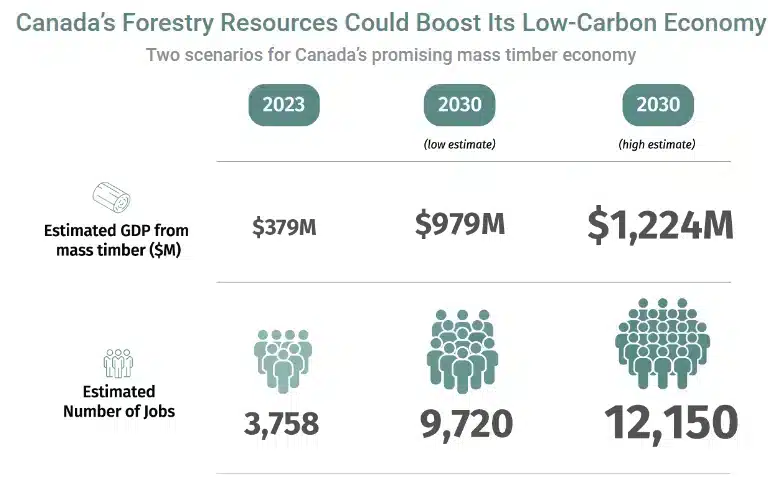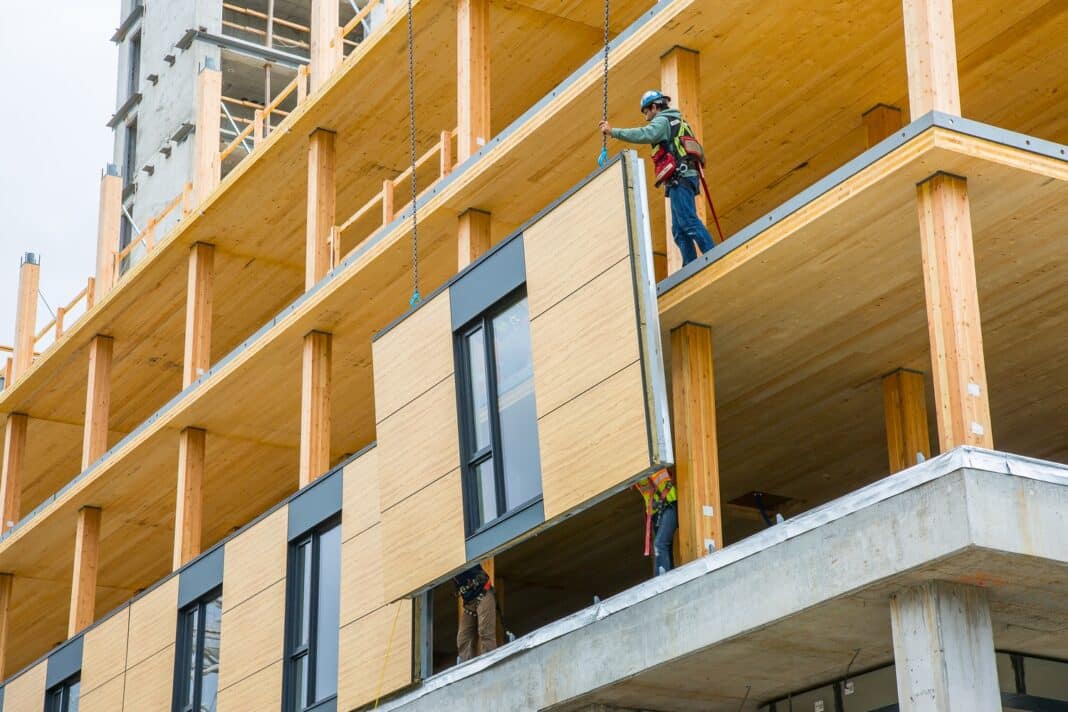Canada has the potential to win the race and become a mass timber powerhouse. And with the right policy settings, it could triple production from CA $379 million in 2023 to CA $1.2 billion by 2030 and even top $2.4 billion by 2045, becoming an incubator for tall construction worldwide.
That is according to The Mass Timber Roadmap, which was revealed at Canada’s Parliament Hill yesterday. Developed in partnership with the Forest Products Association of Canada (FPAC), Canadian Wood Council (CWC), and Energy Futures Lab (EFL), the new plan comes after Canada’s largest bank, the RBC, published a report outlining the country’s opportunity seize the initiative and capture 25% of the global market for mass timber.
Nonetheless, Canada is trailing Europe and risks being overwhelmed by European cross-laminated timber, laminated-veneer lumber, and glulam producers flooding Canadian ports. “Countries are in a race to seize the benefits and the opportunities mass timber provides in the transition to a net-zero world,” the report said, “countries are using industrial policies to position their firms in rapidly forming global value chains.”
“To compete globally, Canada must create an efficient, integrated forest-to-buildings value chain. Time is of the essence!”
As it stands, more than 700 mass timber buildings have been constructed across Canada, with almost 90% clustered around the populated centres of British Columbia (home to Vancouver), Ontario (Toronto), and Quebec (Montreal). More than 140 additional buildings are in the pipeline.
“Mass timber is primed to become a mainstream material of choice in residential applications, especially the 4-6 storey range and more common 7-12 storey buildings, including hybrid structures, combining wood with steel and concrete,” the report said.
“Mass timber designs, especially incorporating prefabrication and modular approaches, offer a promising strategy to accelerate the construction of multi-unit residential structures at greater speeds and lower costs.”
The Mass Timber Roadmap.
According to Derek Eaton, Director of the Future Economy for Canada’s Transition Accelerator, “mass timber provides a perfect example of how Canada can add value to its primary resources through innovative technologies and advanced skills.” Before adding, “If we act strategically and quickly, we can build an industry that reduces emissions, addresses urgent needs, and positions Canada to win in emerging global value chains.”

The report comes amid a surge in interest in mass timber-based systems, which made up just 1% of the North American building materials market in 2022. In March, the University of Georgia published a study forecasting that the US market will grow 25-40 fold over the next 50 years.
“To build a world-class mass timber sector, Canada must adopt a strategic approach to ensure we can compete and win globally,” said Kate Lindsay, Senior Vice President and Chief Sustainability Officer at the Forest Products Association of Canada. “This is about smart policy at home and bringing more Canadian wood to our cities and the world.”
“By enabling faster, cost-effective, and environmentally friendly construction with mass timber, we can create jobs, help address the affordable housing crunch, and reduce emissions.”
Speaking at a Q&A session following the report’s release, Rick Jeffery, the President and CEO of the Canadian Wood Council, said the industry must now “act swiftly” to stay competitive and meet demand.
“The potential for Canadian wood products to reduce the carbon footprint of the built environment and drive the growth of a sustainable and prosperous wood industry is immense,” he said, “however, global competition to capitalise on the significant economic opportunities…will require us to act swiftly to stay competitive and meet rapidly emerging domestic demand.”

What are the next steps?
To achieve the targets laid out in The Mass Timber Roadmap, the authors are now pushing for coordinated efforts across three critical action areas, and the report provides actionable next steps, including:
1. Public-Private Collaboration: The Mass Timber Roadmap calls for a partnership between public and private sectors to develop and advance a comprehensive policy package that will enhance the value of Canada’s forest resources while building domestic capacity along the supply chain.
2. Standardisation: Standardising building archetypes, wood specifications, and connectors throughout the supply chain will streamline processes and reduce costs.
3. Skills Development: Implementing a robust skills development plan that encompasses all aspects of the supply chain is essential to support the sector’s growth.
The global mass timber market
According to the RBA, the global mass timber market reached CA $1.9 billion in 2023. Analysts estimate that if demand grows at 14.5% annually, it could reach CA $4.9 billion by 2030.
As it stands, Canada’s market share of mass timber (up to 2023) is just under 20% of the global market, with the RBA forecasting that under a scenario where Canada increases production capacity and captures 25% of the worldwide market, the country could see economic output surpass CA $1.2 billion by 2030.

“While there are no official employment data for the mass timber sector, we estimate that the sector employs, directly and indirectly, about 4,000 Canadians in 202311. The sector’s job growth is anticipated to triple by 2030 to a high of 12,150 jobs across manufacturing, technology, forestry, design and engineering if future demand materialises,” the RBA said.






